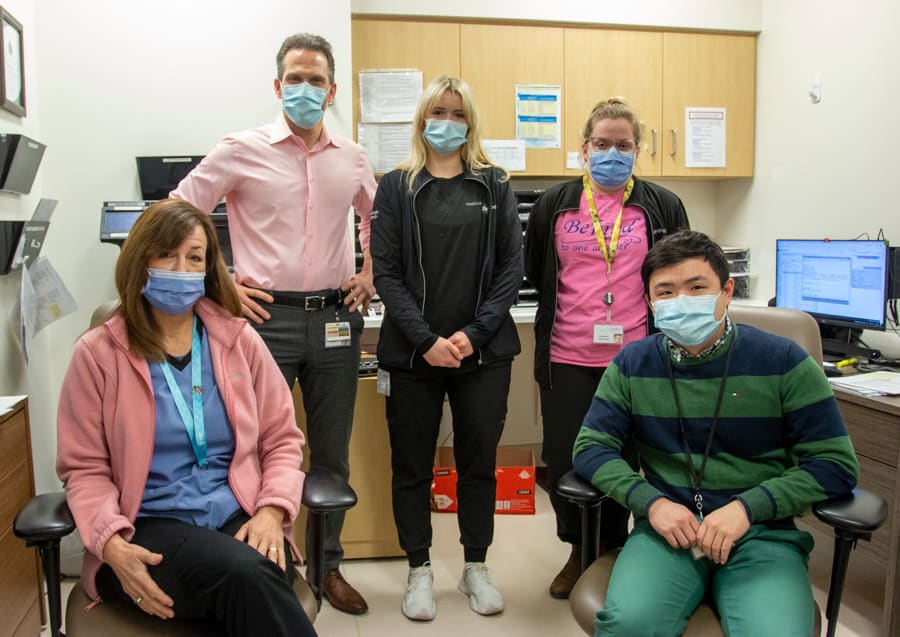The research we conduct at Niagara Health has a profound impact on the health and well-being of our patients and communities, and contributes to better understanding some of the most significant healthcare challenges of our time and have the potential to benefit patients in Niagara and across Canada.

(From left): Kim Mcdonough, Registered Nurse; Dr. Blair Leonard, Director of Niagara Thrombosis Service and Regional Physician Lead for Benign Hematology and Thrombosis; Kailee Morrison, Research Co-ordinator; Alexandra Tonellato,Ward Clerk; and Tommy Liu, Pharmacist, of the Niagara Thrombosis Service. A recent grant from the Ottawa Hospital Research Institute has enabled the Service to launch four clinical trials with a fifth in the works that will improve the care thrombosis patients receive in Niagara and beyond.
Clinical trials getting underway in Niagara Health’s Thrombosis Service will give patients access to some of the newest treatments for preventing deadly blood clots.
Some of those trials include the ANTHOS trials, investigating promising novel blood thinners that aren’t yet available to patients and doctors elsewhere.
“You can go all over Canada and lots of places have never heard of these medications,” says Dr. Blair Leonard, Director of Niagara Thrombosis Service and Regional Physician Lead for Benign Hematology and Thrombosis. “That’s how cutting edge these are and this research is.”
It’s research that’s also vitally important for treating and managing a common yet serious condition that’s also preventable.
One in four people die from causes related to thrombosis, which is the formation of potentially deadly blood clots in the artery (arterial thrombosis) or the vein (venous thromboembolism or VTE). Once formed, a clot can slow or block normal blood flow. It can even break loose and travel to an organ, resulting in disability or death.
The Niagara Thrombosis Service is currently participating in four clinical trials whose findings will benefit patients around the world. The other studies include the SAVER Trial, a multi-centre investigation to determine if statins, a cholesterol-lowering medication, can help prevent VTE; and the TRIM-Line Trial, looking at strategies to prevent blood clots in patients using PICC lines.
With the groundwork being laid for a fifth study dealing with post-thrombotic syndrome (PTS), which is the ongoing symptoms of blood clots, Niagara Health has positioned itself as a leader in thrombosis research.
Proving Niagara Health's research prowess
And it’s done so in a short time under the leadership of Dr. Leonard, who steered the launch of Niagara Health’s Thrombosis Service in 2015 to satisfy the need for focused thrombosis care in the region.
Previously, thrombosis patients were treated by generalists or had to travel outside Niagara for specialized care, and only if physicians and programs elsewhere elected to take them on. Today, Niagara Health’s Thrombosis Service has five dedicated thrombosis specialist physicians, including Dr. Leonard, who run two clinics every day at the St. Catharines Site, and provide 24/7 patient coverage across the region.
“The plan when we launched was to satisfy the tremendous clinical need, then branch into research and teaching,” Dr. Leonard says, adding the service took on its first resident last year.
Dr. Leonard began demonstrating Niagara Health’s prowess in thrombosis research in 2018 when he used retrospective data to investigate the use of warfarin, a common blood thinner, in patients with heart valves.
In 2021, he published preliminary results about VTE prophylaxis in outpatient oncology patients at the Walker Family Cancer Centre. Over the last three years, the thrombosis team participated in the COACHED clinical trial with McMaster University that looked at inpatient use of warfarin and the need for monitoring and adjusting dosing during the transfer of care back to family physicians.
That work set up Niagara Health for a significant grant from the Ottawa Hospital Research Institute (OHRI) to participate in larger, randomized patient trials, like those currently in the works, and expand the team to add Research Co-ordinator Kailee Morrison.
“We started to get recognition as a place that had keen research interest and potential,” Dr. Leonard says. “The main thing is OHRI saw our desire to be involved in research and how innovative we were at attracting research with limited resources.”
Providing high-quality patient care
Morrison, who joined Niagara Health in January, helps with research ethics applications and works with Dr. Leonard to identify and recruit patients. She also provides training to study participants and does non-medical follow-up throughout trials. That includes regular patient check-ins, reviewing patient charts and keeping the lines of communication between participants and the research team open.
The trials vary in length from 90 days to three years, and retention can be a challenge for longer studies, she notes. The success of the trials depends on the ability to ethically recruit patients, however, with one study needing as many as 144 people.
Most participants will come from the Walker Family Cancer Centre because thrombosis is a common complication of chemotherapy, Morrison explains. But the hope is to work with departments throughout Niagara Health to recruit a wide variety of study candidates.
“For some of the trials, we won’t have patients walking into the (thrombosis) clinic,” she says. “We want them to not just send us patients but we want them to send us patients because the patient benefits from participating.
“Seeing people go through these and for the whole duration will be really rewarding.”
Ultimately, the goal is to continue expanding the breadth of thrombosis research at Niagara Health and with it, provide the highest quality, most up-to-date care to patients.
“Our research division brings cutting edge care to Niagara,” Dr. Leonard says. “When we launched the service, we expected to have a dramatic effect on improved treatment in VTE and PTS. We’ve done that and we wouldn’t have had that without the emphasis on research here from our humble beginnings.”

